People
‘I Use It as a Way of Drawing and Seeing’: Artist Mickalene Thomas on How Photography Became the Center of Her Practice
The artist was honored at the ICP Spotlights luncheon. Here are five takeaways from the talk.
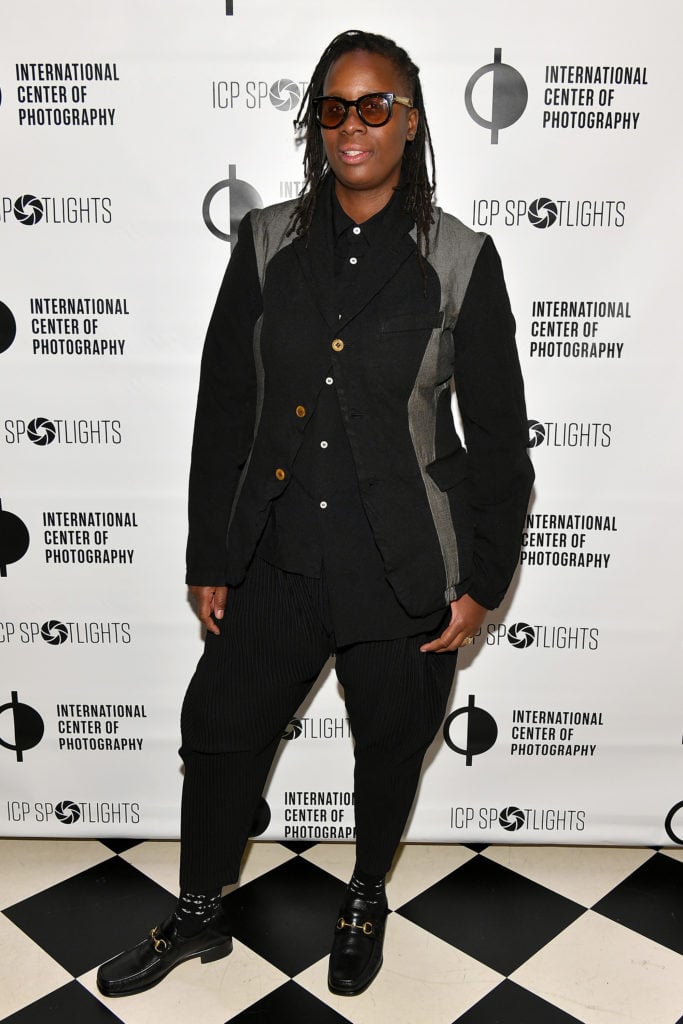
The artist was honored at the ICP Spotlights luncheon. Here are five takeaways from the talk.

Sarah Cascone

When you think of Mickalene Thomas, you might not think of photography. But it was for that lesser-known side of her practice that the artist was honored this week at the International Center of Photography’s annual ICP Spotlights benefit, honoring the accomplishments in film and photography of women in the visual arts.
“What photography has allowed me to do within my work is to expand what’s possible in my creative practice. It’s opened a door on so many levels,” Thomas said during the lunch. “I use photography for all of the different bodies of work—my landscapes, my interiors, the portraits, my silk screens. Photography is the center of my practice; I use it as a way of drawing and seeing.”
“The difference between painting and photography for me is that there is this element of truth in photography sometimes that you get. Painting, there is this play you can manipulate this images—this fantasy that you can push to the edge with changing things up as you go,” she added. “I love working with film because there’s always a moment of surprise after your negatives develop and you get your contact sheets.”
Thomas was speaking with author and academic Beverly Guy-Sheftall, the founding director of the Women’s Research and Resource Center at Spelman College, Atlanta. The two discussed everything from Thomas’s studies at Yale—getting her MFA was a good thing, but even without it, “I would probably still be where I’m sitting”—to her upcoming projects. Thomas will debut her first public artwork next year in Milwaukee, a 14-foot fiberglass sculpture of a black woman.
Here are five more takeaways from the talk.
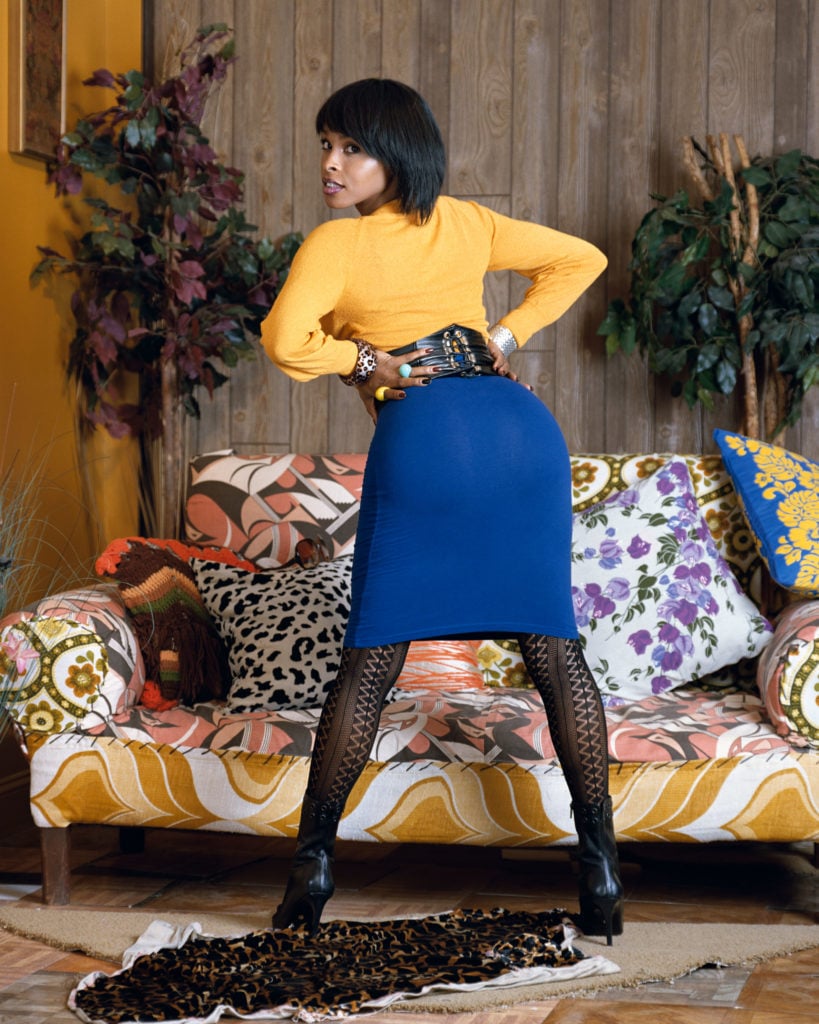
Mickalene Thomas, Put Something Down on It (2009). Photo courtesy the artist and Lehmann Maupin, New York, Hong Kong, and Seoul, ©Mickalene Thomas/Artist Rights Society (ARS), New York.
In 1994, I walked into the Portland Art Museum and saw Carrie Mae Weems’s work—specifically “The Kitchen Table” series, and that was transformative. Not only to me as a young black girl from Camden, New Jersey, standing in a museum in Portland, Oregon, but as a queer woman, as a young artist, seeing those works—they changed my life and allowed me to really consider being an artist.
My journey began the moment I walked into that museum. I had some type of aspiration of finding security, and I was thinking that I was going to be a lawyer. I was working at a law firm as a paralegal. A friend of mine, Chris Stark, was taking some photo classes… It was he who dragged me to the show. If it wasn’t for him, I probably wouldn’t be sitting here.
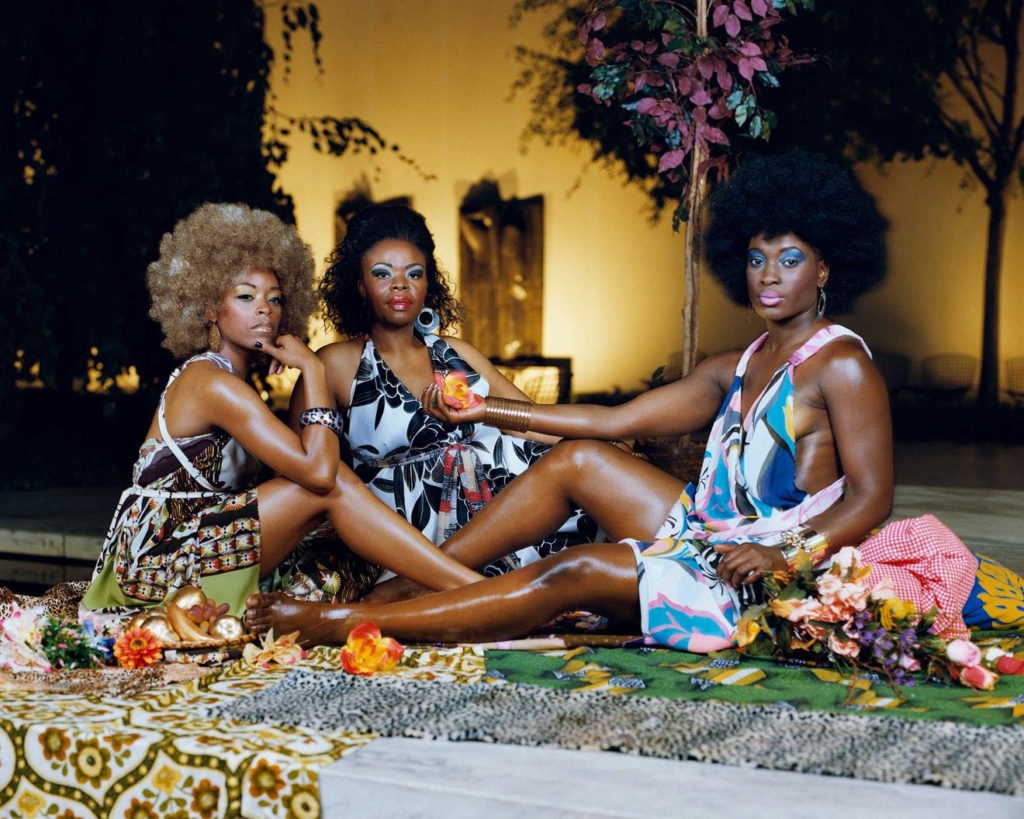
Mickalene Thomas, déjeuner su Therbe: Las Trois Femmes Noires (2010). Photo courtesy of the artist and Lehmann Maupin, New York, Hong Kong, and Seoul.
In the beginning, a lot my photographs were used as resources for my paintings. I wasn’t as confident thinking that photographs could stand on their own. Because for me they were always references for my paintings… I’d [use them to] make collages for paintings. But it wasn’t until I picked up the medium format camera, a Mamiya, that really transformed my photographs once again. I began to understand that this was a powerful tool; that I could use these images as telling a story about the blackness of my skin that I could not tell in paintings.
I don’t think all my photographs are good. Sometimes, I think they are crap. The lighting is bad—but I like that. It’s about bad lighting. It’s about this novice, this untrained photographer. To me, that’s the theater. That’s the performance. Because I don’t know that much about photography, I use the not knowing as the making of the photographs.
So many other photographers could be sitting where I am. I acknowledge that, and I’m honored that I’m here. There are people who use photography as their livelihood. I use photography in my creative practice, but it’s not my primary practice… I’m always honored and thankful that people are responding and looking at my photographs with the same weight.
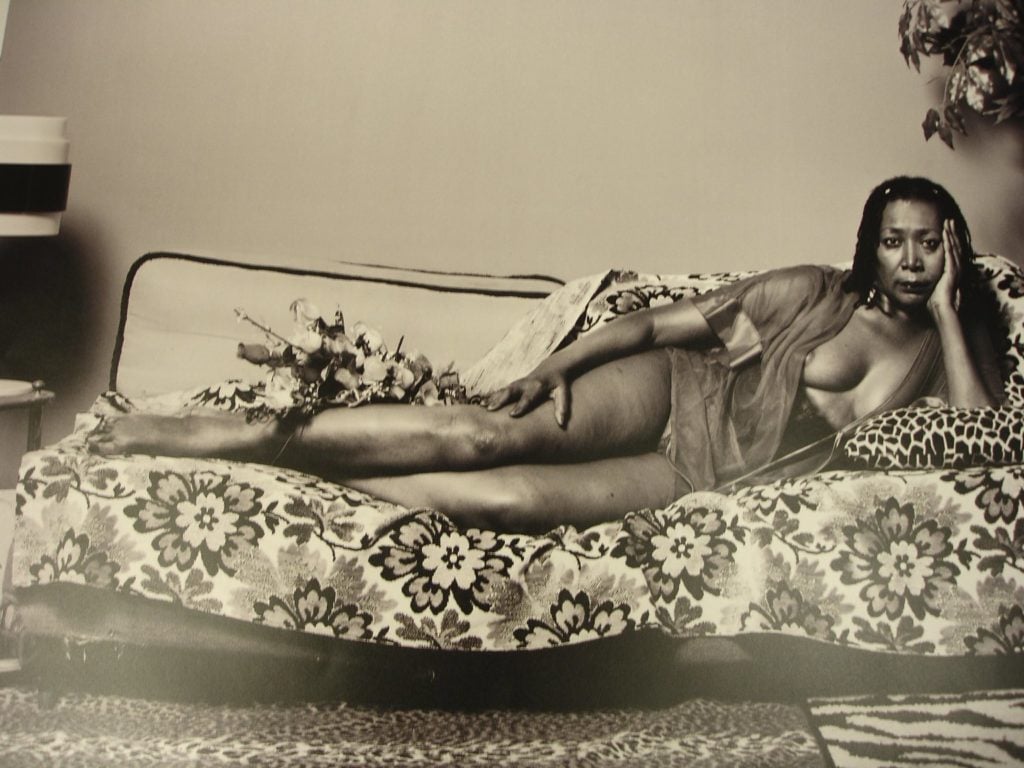
Mickalene Thomas, Madame Mama Bush in Black and White (2007). Photo courtesy of the Brooklyn Museum of Art, Elizabeth A. Sackler Center for Feminist Art.
At Yale, I took a photo class with David Hilliard… It changed my practice, and it changed how I worked. He came to me and said, “Why don’t you photograph someone in your life who you have some complications with?”
At the time, my mother and I weren’t really speaking, so I thought it was a nice way of rekindling a relationship. I went back to Jersey and brought these Pam Greer-like outfits and photographed her in her apartment. What that did for me was that I began to see myself. I began to understand her as an individual and a mother, and me as a daughter and an artist.
And I began to look at and understand her black body and her own trajectory. Her own spaces in the world. And that allowed me to understand who I was and the conflict that I was having… I use all of that residue and dirt and muck and quagmire to feed the artist process.
My mother—reclined as the odalisque—claiming that space of black women’s sexuality and sensuality and her body at the time—her 55-year-old body—and loving all aspects of that. That allowed me to look at my own body in the mirror and begin to love all of the beauty and also the irregularities of all the ideas of what beauty is supposed to be. So I could see myself. My mother owning it allows me to own it as well.
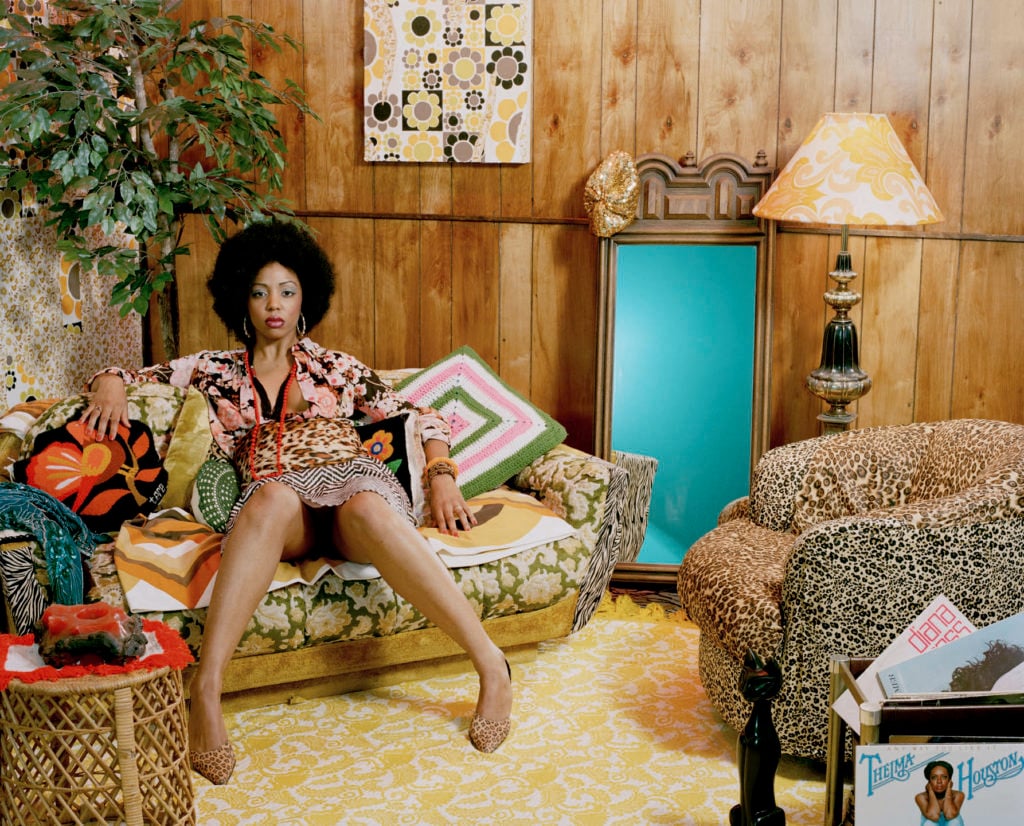
Mickalene Thomas, Lovely Six Foota (2007). Photo courtesy the artist and Lehmann Maupin, New York, Hong Kong, and Seoul, ©Mickalene Thomas/Artist Rights Society (ARS), New York.
There was this need to express my sexuality without being heavy-handed. And I didn’t want to use myself. It was easier to use conduits—other women to fill in that space to speak about this intimacy. Those were images that I wasn’t seeing enough of… [It was about] wanting to see more images who look, talk, walk like me in art history.
I do recognize the power of these images, this woman, her stance, her power, her owning and claiming of her space.
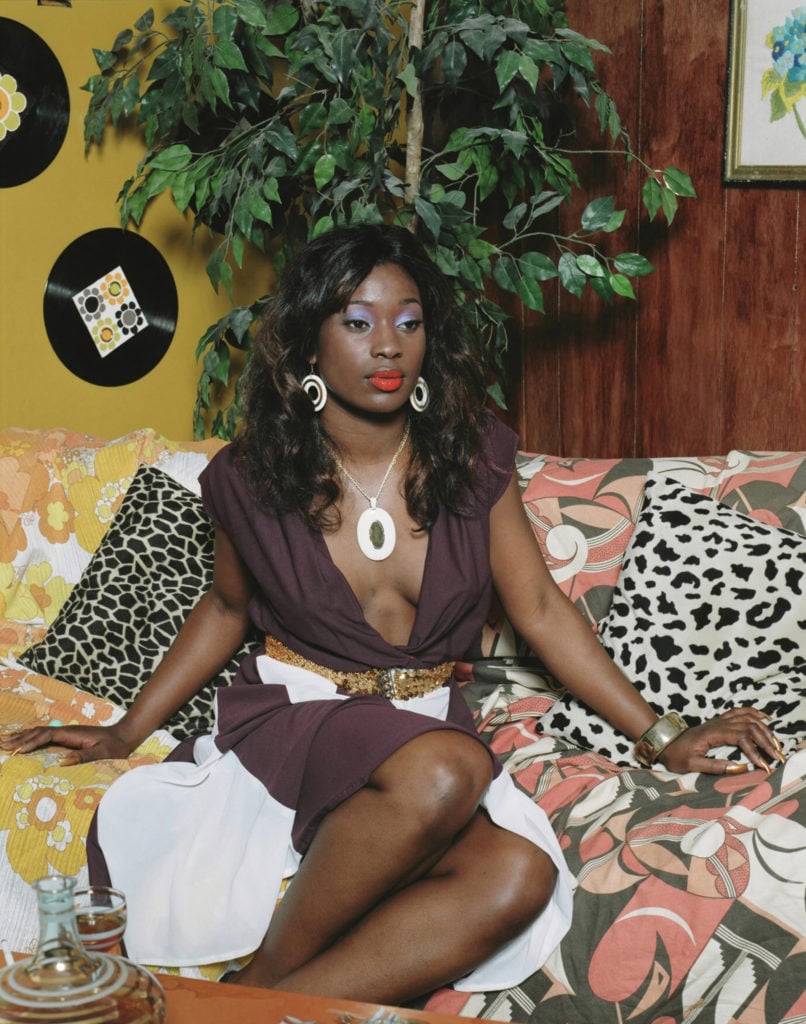
Mickalene Thomas, Portrait of Qusuquzah (2008). Photo courtesy the artist and Lehmann Maupin, New York, Hong Kong, and Seoul, ©Mickalene Thomas/Artist Rights Society (ARS), New York.
I’m not comfortable talking about it, but I think there is a conversation to be had. I’m not at the right time, because there was a lot of emotion behind it. Mainly because it was very close to someone I know very well—an artist that I share a gallery with… But I’m not the first woman who this has happened to. Male artists, specifically white male artists, do it all the time. There is a larger conversation around that that needs to be told, and I’m hoping to do an Op-Ed piece about it.
The excerpts from this conversation have been edited and condensed.